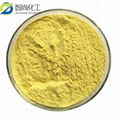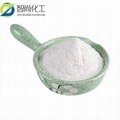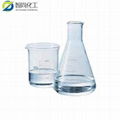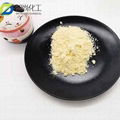| Model: | - |
|---|---|
| Brand: | ZSpharmac |
| Origin: | - |
| Category: | Chemicals / Chemical Waste / Cosmetics Chemicals |
| Label: | - |
| Price: |
-
|
| Min. Order: | 1 pc |
Product Description
| Product Name: | NEROL |
| Synonyms: | (3Z)-3,7-Dimethyl-2,6-octadiene-1-ol;NEROL EXTRA LG FCC;NEROL PRIME;NEROL, NATURAL;cis-3,7-Dimethyl-2,6-octadien-1-ol, Nerol;Nerol,97%;Nerol,cis-3,7-Dimethyl-2,6-octadien-1-ol;cis-3,7-Dimethyl-2,6-octadien-1-ol,cis-3,7-Dimethyl-2,6-octadien-1-ol, Nerol |
| CAS: | 106-25-2 |
| MF: | C10H18O |
| MW: | 154.25 |
| EINECS: | 203-378-7 |
| Product Categories: | Cosmetic Raw Materials; Flavors and Fragrances; Plant Extracts |
| Melting point | <-15 °C |
| Boiling point | 103-105 °C/9 mmHg (lit.) |
| density | 0.876 g/mL at 25 °C (lit.) |
| FEMA | 2770 | NEROL |
| refractive index | n20/D 1.474(lit.) |
| Fp | 226 °F |
| storage temp. | 2-8°C |
| solubility | absolute ethanol: soluble(lit.) |
| pka | 14.45±0.10(Predicted) |
| form | Liquid |
| color | Clear colorless to almost colorless |
| Water Solubility | 1.311g/L(25 ºC) |
| Identification test | Determination of total alcohol (OT-5). The amount of sample taken is 1.2g; the equivalent factor (e) in the calculation is 77.13. |
| Chemical properties | Colorless oily liquid It bears a sweet smell similar to the fresh rose, better than geraniol, and with hints of lemon flavor. The boiling point is 227 ℃; flash point is 92 ℃; optical rotation is [α] D ± 0 °. Miscible in ethanol, chloroform and ether; nearly insoluble in water.
It is the isomer of geraniol (trans; geraniol is cis). Natural lanolin and its esters are found in orange leaf oil, rose oil, lavender oil, Sri Lanka citronella oil, bitter orange blossom oil and bergamot, lemon, white lemon, grapefruit, sweet orange and so on. |
| Uses | The food flavors are mainly for the preparation of raspberry, strawberry and citrus fruit flavors and preparation of orange blossom, rose, magnolia main spices. It is a spice commonly used in jasmine, white flowers, lilac, lily of the valley, narcissus, carnation, mimosa, violet, vanilla, cymbidium, tuberose and citrus cologne. It is also commonly used in hyacinth, gardenia, osmanthus, acacia flavor formula. In the food flavor, its raspberry-strawberry flavor effect is commonly used. The product is also used in the preparation of daily makeup fragrance, such as violet, orange blossom, jasmine, lily of the valley, magnolia, cloves and other fragrance type makeup fragrance. It is widely used in orange blossom, rose, jasmine, tuberose and other fragrances of fragrant type and food flavor of raspberry, strawberry. It can also be used to produce ester spices. |
| Preparation | 1. Oil of petitgrain is used as raw material; the first step is eliminating linalool and terpenes through fractionation; through saponification the fraction containing primary alcohol will be made into phthalate esters; and then going through purification and alkali saponification, geraniol (60 %) and nerol (40%) mixture is derived; removing geraniol with lead chloride, undergoing the residue vacuum distillation or steam distillation, the product was derived.
2. Let the geraniol and hydroiodic acid reacted in the neutral solution. Removing excess hydrogen iodide with alkali, the nerol mixed with geraniol can be derived, and then separate the mixture using the above method. 3. Heat the mixture of the same amount of camphor and acetic anhydride to boiling in the presence of sodium acetate. The mixture of geraniol and neryl alcohol can be derived through saponified esterification, and then separate the mixture by the former method. 4. Reducing citral in the isopropanol solution containing isopropanol aluminium also can obtain the mixture of geraniol and nerol, and nerol is derived through re-separation. |
| Toxicity | GRAS (FEMA).
LD504500 mg/kg (rat, oral). maximum level FEMA (mg/kg): soft drink 1.4; cold drink 3.9; candy 16; baked food 19; pudding 1.0 to 1.3; utilization limitation (FDA $ 172. 515, 2000). |
| Description | Nerol has a fresh, sweet, rose-like odor and a bitter flavor. Nerol may be synthesized from pinene. |
| Chemical Properties | Nerol has a fresh, sweet, rose-like odor and a bitter flavor. |
| Chemical Properties | Clear colorless to almost colorless liquid |
| Chemical Properties | Nerol occurs in small quantities in many essential oils where it is always accompanied by geraniol; its name originates from its occurrence in neroli oil. Nerol is a colorless liquid with a pleasant rose-like odor, which, unlike that of geraniol, has a fresh green note. Nerol undergoes the same reactions as geraniol but cyclizes more readily in the presence of acids.
Nerol is produced along with geraniol from myrcene in the process described for geraniol. It can be separated from geraniol by fractional distillation. Nerol is used in perfumery not only for the same purposes as geraniol, for example, in rose compositions, to which it lends a particular freshness, but also in other blossom compositions. In flavor work, it is used for bouquetting citrus flavors. Technical-grade nerol, often in a mixture with geraniol, is used as an intermediate in the production of citronellol and citral. |
| Occurrence | Reported found in neroli oil (with geraniol) and in the essential oils of lemongrass, Ceylon citronella, ylangylang, champaca, Cayenne Bois de Rose and bergamot; also in lemon, sweet orange and petitgrain bergamot; in clary sage, lavandin, lavender, Mexican linaloe, myrrh, jasmine, Paraguay petitgrain; also reported among the volatile constituents of currant aroma; Helicrysum angustifolium contains up to 30 to 50% nerol. Also reported found in citrus peel oils and juices, apricot, cranberry, blueberry, currant, grapes, papaya, raspberry, blackberry, strawberry, potato, tomato, cinnamon, ginger, mentha oils, mustard, nutmeg, thyme, hop oil, beer, gin, cognac, brandy, grape wines, tea, honey, Arctic bramble, passion fruit, prune, Japanese plum, rose apple, marjoram, mango, tamarind, cardamom, coriander seed and leaf, tarragon, litchi, licorice, buckwheat, laurel, wort, elderberry, cherimoya, myrtle leaf and berry, buchu oil, Bourbon vanilla, lemon balm, clary sage, loganberry, maté, German chamomile oil and mastic gum leaf oil. |
| Uses | Nerol is a flavoring agent that is a colorless liquid with an odor resem- bling fresh, sweet roses and contains geranoils and other terpenic alcohols. it is miscible in alcohol, chloroform, and ether insoluble in water. it is obtained by synthesis. it is also termed cis-3,7-dime- thyl-2,6-octadien-1-ol. |
| Uses | Nerol is an isomer of Geraniol (G367000), used in the synthesis of insect repellant. It is also used in the synthesis of Angelicoin A and Herecinone J, which inhibit collagen-induced platelet aggregat ion. |
| Uses | nerol is a primary alcohol used in perfumes, especially those with rose and orange blossom scents. nerol is a naturally occurring fraction in oil of lavender, orange leaf, palmarosa, rose, neroli, and petitgrain. It is colorless and has a rose-like scent. |
| Definition | ChEBI: The (2Z)-stereoisomer of 3,7-dimethylocta-2,6-dien-1-ol. It has been isolated from the essential oils from plants like lemon grass. |
Member Information
| Shandong Zhishang Chemical Co., Ltd. | |
|---|---|
| Country/Region: | Shan Dong - China |
| Business Nature: | Trading Company |
| Phone: | 18888290058 |
| Contact: | William (General manager) |
| Last Online: | 20 Oct, 2021 |




